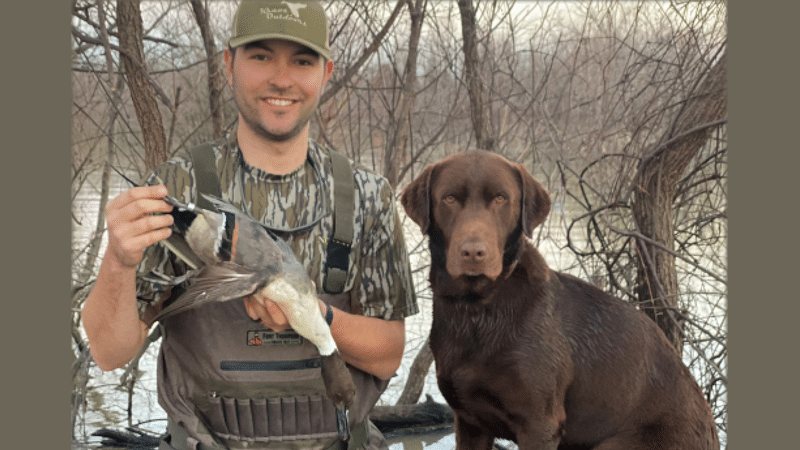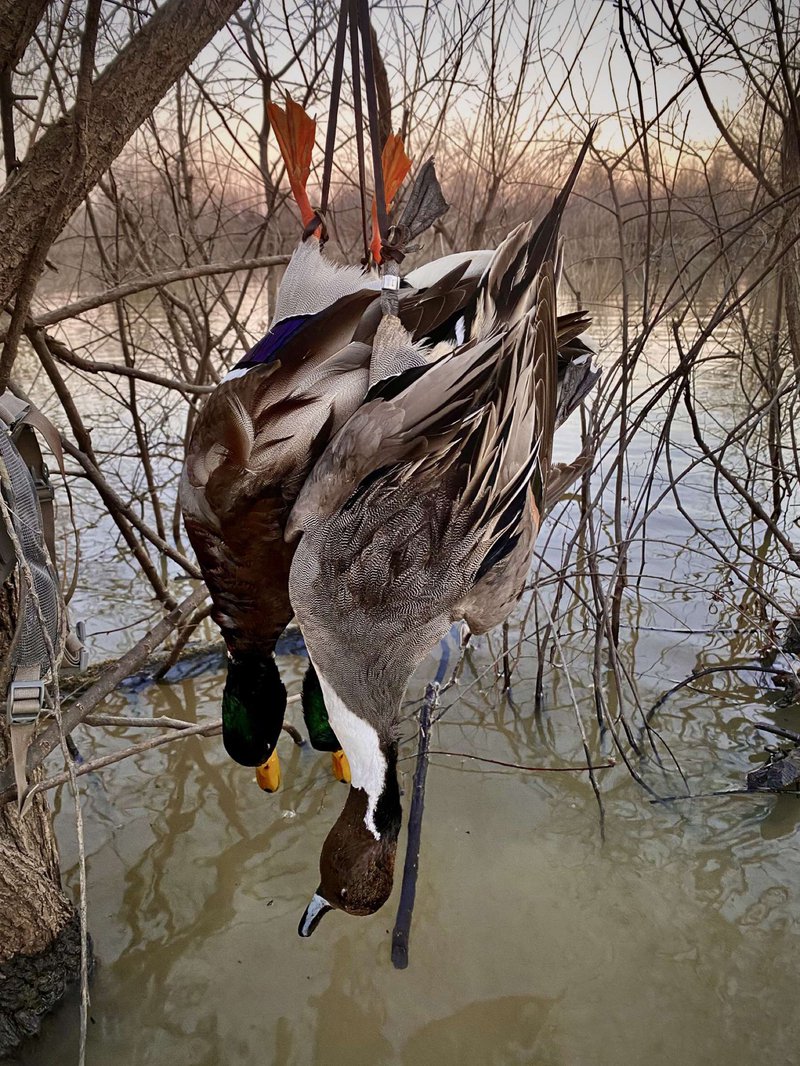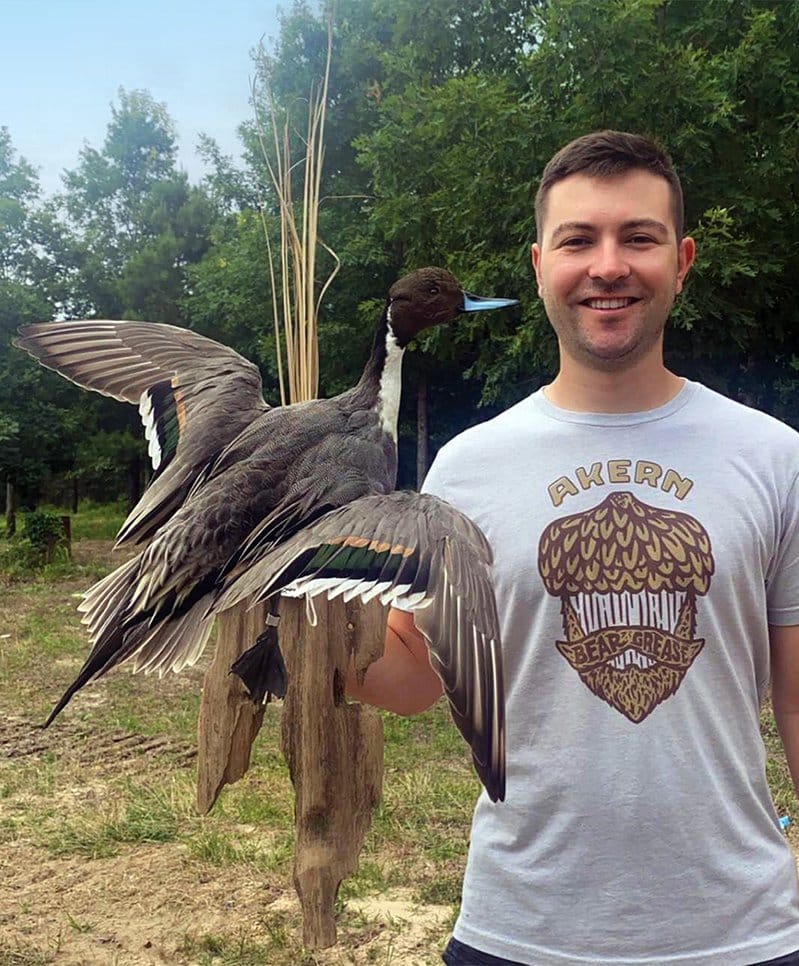Last-second shot 16 years in the making
ON 12-14-2022

Dec. 14, 2022
Randy Zellers
Assistant Chief of Communications
Waterfowler shares amazing history of wise old pintail
Waterfowl hunters spend a few moments now and then scrolling through photos in a smartphone or sifting through pictures of duck camp, reflecting on cold mornings and warm memories. Robbie Morphew has an even better reminder of a once-in-a-lifetime experience wrapped around a lanyard that holds his duck calls.
The Army Corps of Engineers ranger stationed at DeGray Lake was finishing up his ninth season as an Arkansas duck hunter when he and his hunting buddy, Noah Johns, decided to try something new. The two almost exclusively hunt public land but had never been able to get out for the last day of the season, which is open all day instead of ending at noon.
“We’d never actually hunted the last day of the season on public land,” Morphew said. “Noah got tied up that morning, so we headed out to one of our favorite wildlife management areas for one last hunt that afternoon.”
The parking lot still had quite a few trucks with empty trailers, indicating hunters were looking for limits of ducks. They maneuvered around hunting parties in the marsh and worked their way to an out-of-the-way spot laden with buckbrush. With a modest spread of decoys and a good observation point for Costa, Johns’ retriever, they settled in for their buzzer-beater hunt.

It wasn’t long before birds were checking out their spread, but as with most late-season hunts, the ducks were wary of the ruse.
“They were really being finicky,” Morphew said. “Most of the groups would make two or three passes but we just couldn’t get them to put their feet down and finish.”
With about 45 minutes of shooting light left, the hunters had managed a mallard drake during a few hours of work, although the next group of birds would make it all worthwhile.
“We had a pair of pintails start working our spread but they made a wide swing behind a tree line and we lost track of them,” Morphew said. “We honestly thought we’d seen the last of those two ducks and were getting a little frustrated when, all of a sudden, they came in from the side – feet down and ready to land.”
Both hunters rose and shot at almost the same moment, sizing up the male of the pair, leaving the hen to fly away unscathed.
“I really think I whiffed at my first shot,” Morphew said. “But I saw feathers fly off and the drake rear up.”
Johns saw something else when the first shot didn’t cleanly down the bird – the glint of a telltale leg band, used to help biologists learn more about duck populations and habitat use along their migration paths.
“Noah hollered for me to shoot again,” Morphew said. “He didn’t shoot again and let me take the shot.”
Johns didn’t notice that the shell from Morphew’s first shot had failed to eject and had jammed the shotgun’s action. Morphew ripped at the stuck shell. By the time the jam was cleared, there was just enough room for one chance at the bird, which was almost out of range.
“You could just barely see the bird splash down through the buckbrush after I connected on the second shot,” Morphew said. “Noah held Costa back and told me I might want to go get that bird myself. It wasn’t until I was about 5 yards away from it that I finally saw the band on its leg.”
The first thing both hunters noticed was that the numbers engraved in the aluminum were hardly recognizable, and some of the instructions they’d seen on other bands were missing.
They took a pair of mallards, which added another drake greenhead to their game strap, but their eyes kept going back to the odd-looking band. They discovered why the band was different during the drive home.
“We tried to enter the numbers from the band on the reporting website a couple of times and finally we got a confirmation,” Morphew said. “It said, ‘Congratulations on your very old pintail,’ then told us the bird was 16 years old!”
The pintail was banded Sept. 11, 2006, the year it hatched. According to reportband.gov, it was banded under the permit of Michael Szymanski of the North Dakota Game and Fish Department near Crosby, North Dakota, a couple of miles from Saskatchewan. It is the oldest banded pintail harvested and reported in the Mississippi Flyway and the sixth-oldest pintail harvested in the history of the U.S. Geological Survey’s Bird Banding Laboratory. The oldest pintail on record was a 22-year-old bird harvested in Saskatchewan in 1994.

“We spent the rest of our drive home talking about it.” Morphew said. “Think about how many times that duck has come up and down the flyway. How many decoy spreads that bird had seen and not been fooled. It’s still amazing to think about just how many miles that bird likely covered before we got him. It’s more than 2,000 miles in a straight line from Crosby to Arkansas and back, and he likely covered way more than that every year.”
Morphew says a USGS biologist contacted him to verify the harvest and get photos of the bird and the band. The old drake, mounted by a taxidermist, still wears the band. Morphew had replica bands made for his and his hunting partner’s lanyards.
“That was the first band either of us had ever harvested, and I really feel like it was just as much his bird as it is mine,” Morphew said. “I’m just really lucky to have that kind of a hunting partner who would hold up on a bird he knew was banded so I could take the shot. And the first shot was his, so I felt like he should have one of the replica bands.”
Recent News
Subscribe to Our Weekly Newsletter E-mails
Don’t miss another issue. Sign up now to receive the AGFC Wildlife Weekly Newsletter in your mailbox every Wednesday afternoon (Waterfowl Reports are published weekly during waterfowl season and periodically outside the season). Fishing Reports arrive on Thursdays. Fill in the following fields and hit submit. Thanks, and welcome!


